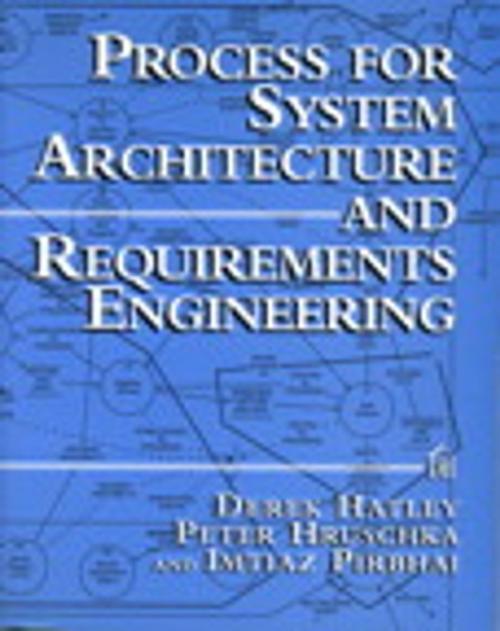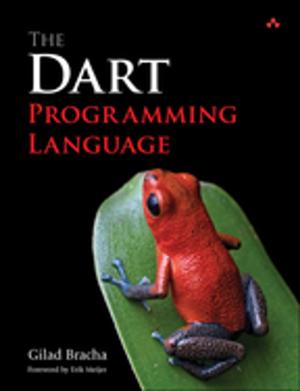Process for System Architecture and Requirements Engineering
Nonfiction, Computers, Programming, Software Development| Author: | Derek Hatley, Peter Hruschka, Imtiaz Pirbhai | ISBN: | 9780133488548 |
| Publisher: | Pearson Education | Publication: | August 2, 2013 |
| Imprint: | Addison-Wesley Professional | Language: | English |
| Author: | Derek Hatley, Peter Hruschka, Imtiaz Pirbhai |
| ISBN: | 9780133488548 |
| Publisher: | Pearson Education |
| Publication: | August 2, 2013 |
| Imprint: | Addison-Wesley Professional |
| Language: | English |
This is the digital version of the printed book (Copyright © 2000).
Derek Hatley and Imtiaz Pirbhai—authors of Strategies for Real-Time System Specification—join with influential consultant Peter Hruschka to present a much anticipated update to their widely implemented Hatley/Pirbhai methods.
Process for System Architecture and Requirements Engineering introduces a new approach that is particularly useful for multidisciplinary system development: It applies equally well to all technologies and thereby provides a common language for developers in widely differing disciplines.
The Hatley-Pirbhai-Hruschka approach (H/H/P) has another important feature: the coexistence of the requirements and architecture methods and of the corresponding models they produce. These two models are kept separate, but the approach fully records their ongoing and changing interrelationships. This feature is missing from virtually all other system and software development methods and from CASE tools that only automate the requirements model.
System managers, system architects, system engineers, and managers and engineers in all of the diverse engineering technologies will benefit from this comprehensive, pragmatic text. In addition to its models of requirements and architecture and of the development process itself, the book uses in-depth case studies of a hospital monitoring system and of a multidisciplinary groundwater analysis system to illustrate the principles.
Compatibility Between the H/H/P Methods and the UML:
The Hatley/Pirbhai architecture and requirements methods—described in Strategies for Real-Time System Specification—have been widely used for almost two decades in system and software development. Now known as the Hatley/Hruschka/Pirbhai (H/H/P) methods, they have always been compatible with object-oriented software techniques, such as the UML, by defining architectural elements as classes, objects, messages, inheritance relationships, and so on. In Process for System Architecture and Requirements Engineering, that compatibility is made more specific through the addition of message diagrams, inheritance diagrams, and new notations that go with them. In addition, state charts, while never excluded, are now specifically included as a representation of sequential machines.
These additions make definition of the system/software boundary even more straightforward, while retaining the clear separation of requirements and design at the system levels that is a hallmark of the H/H/P methods—not shared by most OO techniques. Once the transition to software is made, the developer is free to continue using the H/H/P methods, or to use the UML or any other software-specific technique.
Process for System Architecture and Requirements Engineering introduces a new approach that is particularly useful for multidisciplinary system development: It applies equally well to all technologies and thereby provides a common language for developers in widely differing disciplines.
The Hatley-Pirbhai-Hruschka approach (H/H/P) has another important feature: the coexistence of the requirements and architecture methods and of the corresponding models they produce. These two models are kept separate, but the approach fully records their ongoing and changing interrelationships. This feature is missing from virtually all other system and software development methods and from CASE tools that only automate the requirements model.
System managers, system architects, system engineers, and managers and engineers in all of the diverse engineering technologies will benefit from this comprehensive, pragmatic text. In addition to its models of requirements and architecture and of the development process itself, the book uses in-depth case studies of a hospital monitoring system and of a multidisciplinary groundwater analysis system to illustrate the principles.
Compatibility Between the H/H/P Methods and the UML:
The Hatley/Pirbhai architecture and requirements methods—described in Strategies for Real-Time System Specification—have been widely used for almost two decades in system and software development. Now known as the Hatley/Hruschka/Pirbhai (H/H/P) methods, they have always been compatible with object-oriented software techniques, such as the UML, by defining architectural elements as classes, objects, messages, inheritance relationships, and so on. In Process for System Architecture and Requirements Engineering, that compatibility is made more specific through the addition of message diagrams, inheritance diagrams, and new notations that go with them. In addition, state charts, while never excluded, are now specifically included as a representation of sequential machines.
These additions make definition of the system/software boundary even more straightforward, while retaining the clear separation of requirements and design at the system levels that is a hallmark of the H/H/P methods—not shared by most OO techniques. Once the transition to software is made, the developer is free to continue using the H/H/P methods, or to use the UML or any other software-specific technique.
This is the digital version of the printed book (Copyright © 2000).
Derek Hatley and Imtiaz Pirbhai—authors of Strategies for Real-Time System Specification—join with influential consultant Peter Hruschka to present a much anticipated update to their widely implemented Hatley/Pirbhai methods.
Process for System Architecture and Requirements Engineering introduces a new approach that is particularly useful for multidisciplinary system development: It applies equally well to all technologies and thereby provides a common language for developers in widely differing disciplines.
The Hatley-Pirbhai-Hruschka approach (H/H/P) has another important feature: the coexistence of the requirements and architecture methods and of the corresponding models they produce. These two models are kept separate, but the approach fully records their ongoing and changing interrelationships. This feature is missing from virtually all other system and software development methods and from CASE tools that only automate the requirements model.
System managers, system architects, system engineers, and managers and engineers in all of the diverse engineering technologies will benefit from this comprehensive, pragmatic text. In addition to its models of requirements and architecture and of the development process itself, the book uses in-depth case studies of a hospital monitoring system and of a multidisciplinary groundwater analysis system to illustrate the principles.
Compatibility Between the H/H/P Methods and the UML:
The Hatley/Pirbhai architecture and requirements methods—described in Strategies for Real-Time System Specification—have been widely used for almost two decades in system and software development. Now known as the Hatley/Hruschka/Pirbhai (H/H/P) methods, they have always been compatible with object-oriented software techniques, such as the UML, by defining architectural elements as classes, objects, messages, inheritance relationships, and so on. In Process for System Architecture and Requirements Engineering, that compatibility is made more specific through the addition of message diagrams, inheritance diagrams, and new notations that go with them. In addition, state charts, while never excluded, are now specifically included as a representation of sequential machines.
These additions make definition of the system/software boundary even more straightforward, while retaining the clear separation of requirements and design at the system levels that is a hallmark of the H/H/P methods—not shared by most OO techniques. Once the transition to software is made, the developer is free to continue using the H/H/P methods, or to use the UML or any other software-specific technique.
Process for System Architecture and Requirements Engineering introduces a new approach that is particularly useful for multidisciplinary system development: It applies equally well to all technologies and thereby provides a common language for developers in widely differing disciplines.
The Hatley-Pirbhai-Hruschka approach (H/H/P) has another important feature: the coexistence of the requirements and architecture methods and of the corresponding models they produce. These two models are kept separate, but the approach fully records their ongoing and changing interrelationships. This feature is missing from virtually all other system and software development methods and from CASE tools that only automate the requirements model.
System managers, system architects, system engineers, and managers and engineers in all of the diverse engineering technologies will benefit from this comprehensive, pragmatic text. In addition to its models of requirements and architecture and of the development process itself, the book uses in-depth case studies of a hospital monitoring system and of a multidisciplinary groundwater analysis system to illustrate the principles.
Compatibility Between the H/H/P Methods and the UML:
The Hatley/Pirbhai architecture and requirements methods—described in Strategies for Real-Time System Specification—have been widely used for almost two decades in system and software development. Now known as the Hatley/Hruschka/Pirbhai (H/H/P) methods, they have always been compatible with object-oriented software techniques, such as the UML, by defining architectural elements as classes, objects, messages, inheritance relationships, and so on. In Process for System Architecture and Requirements Engineering, that compatibility is made more specific through the addition of message diagrams, inheritance diagrams, and new notations that go with them. In addition, state charts, while never excluded, are now specifically included as a representation of sequential machines.
These additions make definition of the system/software boundary even more straightforward, while retaining the clear separation of requirements and design at the system levels that is a hallmark of the H/H/P methods—not shared by most OO techniques. Once the transition to software is made, the developer is free to continue using the H/H/P methods, or to use the UML or any other software-specific technique.
More books from Pearson Education
We use our own "cookies" and third party cookies to improve services and to see statistical information. By using this website, you agree to our Privacy Policy















